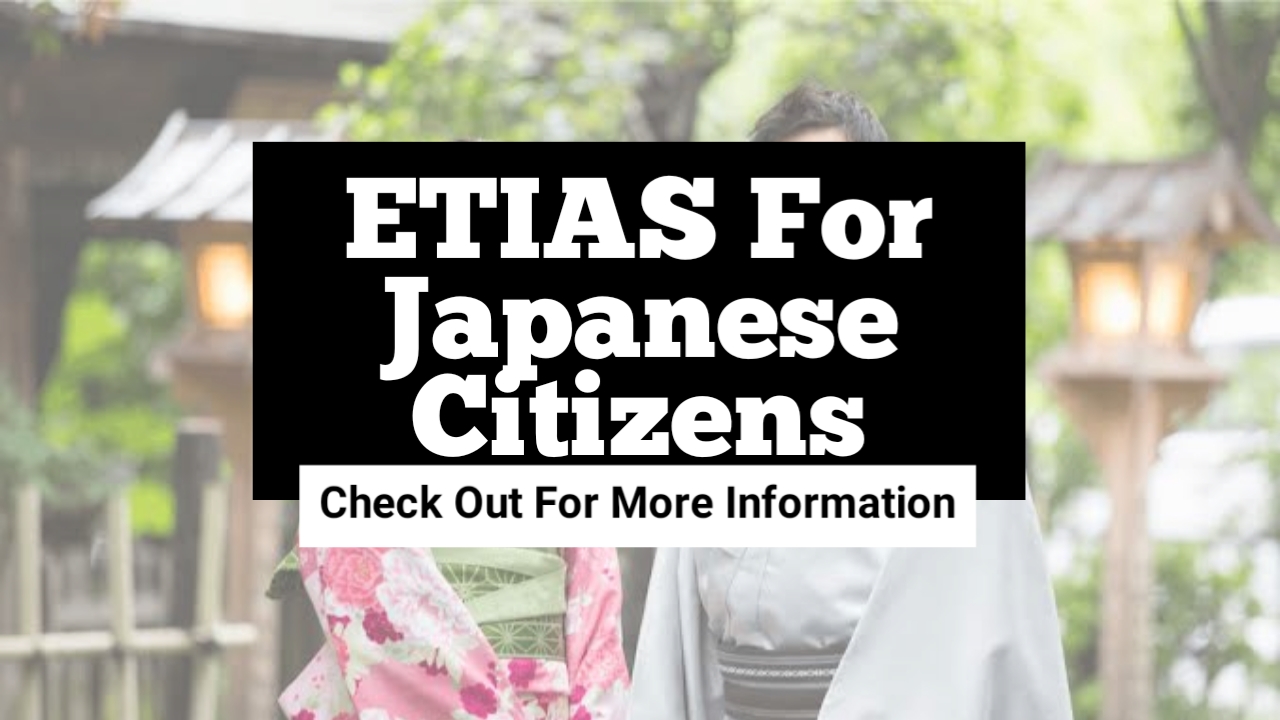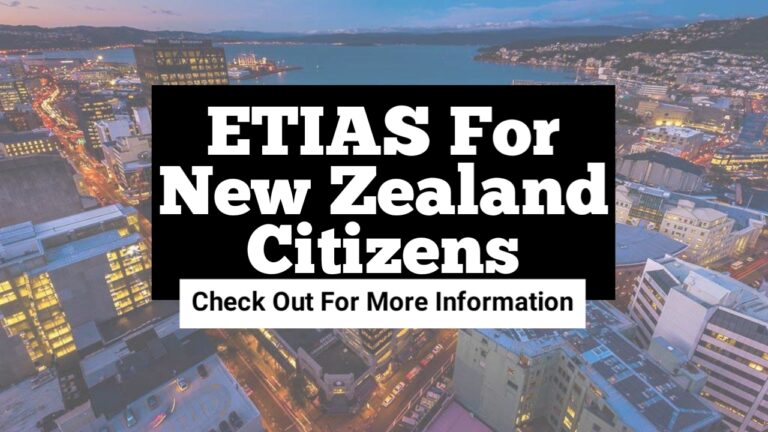ETIAS For Japanese Citizens
Japanese citizens benefit from visa-free travel to Europe for short visits (90 days or less), allowing them to easily travel around the continent. Beginning in the year 2024, citizens of Japan will have to fill out an application for the European Travel Information and Authorization System (ETIAS) prior to making any short-term trips to Europe.
ETIAS is not the same as a visa. Instead, it is a required travel authorization for Europe. Unlike a regular visa which can take a long time to process, an ETIAS can be obtained quickly and easily online. The new immigration system is developed to make the border safer, stop illegal immigration, and curb security risks.
The ETIAS authorization is only required to enter Schengen countries. It includes some of the most popular tourist destinations in Europe for Japanese nationals, such as Italy, France, Spain, and Germany.
What is ETIAS?
ETIAS is a form of electronic travel authorization or visa waiver that allows for pre-arrival screening of travelers from countries including Japan who do not need a visa to enter the EU. The system will keep a record of everyone who enters and leaves the EU.
ETIAS is not the same as the Schengen visa. The ETIAS scheme is being implemented to assist in identifying individuals who may pose a threat to Schengen member countries and to also strengthen border control within the region. Travelers are screened through ETIAS. Any person deemed to pose a security or health threat to the region will not be allowed to enter EU territories.
Once the ETIAS goes live in 2024, Japanese citizens must hold an ETIAS authorization before traveling to any EU member country.
How ETIAS works
When an ETIAS authorization is approved, it is electronically linked to the traveler’s passport. To travel to Schengen, travelers must use the same passport they used to complete the ETIAS application. Those who hold dual citizenship should be aware of this necessity.
When entering the Schengen Area, you need to present your ETIAS-linked passport to border officials, along with other documents such as hotel reservations, an invitation letter, and proof of financial means to stay in Europe. Immigration officials will scan your passport to confirm you have a valid ETIAS endorsement.
The ETIAS authorization is valid for three years from the date of issue, during which time holders can enter the EU multiple times for 90 days in a 180-day period. To stay in the Schengen Area for more than 3 months, you need a visa or another type of permit.
ETIAS holders may visit EU countries for the following purposes:
- Tourism
- Transit
- Business
- Studying a short course
- Attend meetings and conferences.
- Medical treatment
Information About ETIAS For Japanese Citizens:
How to get ETIAS for Japanese citizens
To obtain the ETIAS travel authorization, Japanese citizens do not need to apply in person at any EU country’s embassy or consulate. The ETIAS application process is entirely online, via the designated website (which will go live once ETIAS is operational).
ETIAS requirements For Japanese citizens
Before you start your application, you need the following things:
A valid passport:
Your passport must be valid for at least three months after leaving the Schengen area. On the same page as your biometric information, your passport must also have a section that can be read by a machine.
Email address:
When you fill out the ETIAS application form, you will need to provide a valid email address. This email address will be used by the system to let you know about the status of your application and other important information.
Travel itinerary:
You will need to give information like the first country you plan to visit, how long you plan to stay, your flight tickets, where you will be staying, and any other information that is important for your entry into Schengen.
Debit card or credit card:
Paying the fee is the last step in the ETIAS application process. To pay the application fee, you will need a debit or credit card.
Filling out the ETIAS online application form:
Japan nationals will need to give the following information as part of their ETIAS application:
- Full name
- Date of birth
- Place of birth
- Gender
- Your parents’ information
- Your Japanese passport details (number, issues/expiry date)
- Current address
- Telephone number
- Email address
- Education
- Current occupation
- The first Schengen country you will enter
Additional information:
Details about previous trips to Europe, including whether you have ever been ordered to leave the territory of any country
- Medical condition
- Criminal history
- Any past visits to war or conflict zones
It will take you ten minutes to fill out the form. All of the information you give must be accurate and correspond with what is on your passport. If there are mistakes or missing information, your application could be delayed or even rejected.
ETIAS application processing time for Japanese citizens
ETIAS applications will be processed manually. Most requests are processed within 96 hours (4 days). But some applicants may be asked by national authorities to provide more information or paperwork. In this case, it could take up to two weeks or longer. The applicant will be emailed a list of the additional documents that must be submitted.
Japanese travelers who do not have another form of travel authorization and are still awaiting a decision on their ETIAS application will be denied entry into the EU. To avoid complications, you should apply for ETIAS in advance of your trip.
How much does ETIAS cost for Japanese citizens?
The fee for an ETIAS is €7 (equivalent to 1,079.68 Japanese Yen as at July 2023) for anyone between the ages of 18 and 70. Those under the age of 18 and those who are 70 or older will not be charged for their ETIAS. Either a credit card or a debit card can be used to make a payment.
The application fee is non-refundable if your application is unsuccessful.
When will Japanese citizens need ETIAS to visit Europe?
From 2024 onward, Japanese citizens will need an ETIAS to enter Europe. Keep in mind that the ETIAS is not the same as a visa. It will only take you a short while to fill out an online application and wait for approval. Before the ETIAS requirements take effect next year, you can travel freely to Schengen countries with your passport.
Which countries require an ETIAS for Japanese citizens?
Japanese passport holders will need an ETIAS to visit all thirty (30) EU Schengen member states. This list of countries includes:
Austria, Belgium, Bulgaria, Croatia, Cyprus, Czechia, Denmark, Estonia, Finland, France, Germany, Greece, Hungary, Iceland, Italy, Latvia, Liechtenstein, Lithuania, Luxembourg, Malta, the Netherlands, Norway, Poland, Portugal, Romania, Slovakia, Slovenia, Spain, Sweden, and Switzerland.
Can Japanese citizens enter any EU country with an ETIAS authorization?
Yes. With an ETIAS endorsement, you can visit any of the Schengen countries. But you must enter through the first country you listed on your application, so keep that in mind. After entering your first country, you have 90 days to visit any other country in the Schengen Zone.
For example, suppose you planned to visit Portugal and Spain, and in your application you indicated that Portugal would be the first place you would go. If that’s the case, you must first visit Portugal before going to Spain or any other EU country you want to visit.
Do Japanese nationals need an ETIAS to enter the UK?
No. The UK is not a member of the EU, so visitors are not required to obtain an ETIAS authorization. Japanese nationals who are traveling as tourists are permitted to reside in the UK for up to 6 months without a visa.
Japanese travelers will also not need ETIAS authorization to enter other European countries that are not part of the EU. These countries include: Albania, Armenia, Azerbaijan, Belarus, Bosnia and Herzegovina, Georgia, North Macedonia, Moldova, Montenegro, Russia, Serbia, Turkey, and Ukraine.
What paperwork do Japanese citizens need when visiting the EU?
When visiting Schengen territories, citizens of Japan will need the following paperwork:
- Your Japanese passport (it should be valid for at least three months beyond your intended date of departure from the Schengen area)
- ETIAS Authorization (starting from 2024)
- Proof of accommodation
- Proof of sufficient funds to support yourself during your entire stay in Europe
How long are Japanese citizens allowed to stay in Schengen with an ETIAS?
With an ETIAS, Japanese citizens can stay in Europe for a maximum of 90 days within a 180-day period.
What is Schengen’s 90/180-day rule?
Basically, the 90/180-day rule means your total stay in the Schengen area must be no more than 90 days in every 180 days. Your 90 days start on the first day you enter any Schengen country and stop on the date you leave the area.
But you do not have to stay for 90 consecutive days because the visa waiver agreement allows visitors to travel in and out of Schengen as many times as they want in accordance with the 90/180-day rule.
The 180 days are counted as a rolling period, which you can count backwards from the date you entered or left Schengen. So, to confirm your stay, count back 180 days from your last trip to Schengen and see how many of those days you were in the Schengen region.
The official Europa.eu website features an easy-to-use calculator (https://ec.europa.eu/assets/home/visa-calculator/calculator.htm?lang=en) that you can use to determine the total number of stays you have accumulated.
What happens if you overstay the 90 days allowed in the Schengen Area?
If you violate the Schengen 90/180 day rule by overstaying your 90 days, you may face a fine, immediate deportation, or even be banned from entering the Schengen Area for a while.
Can Japanese citizens work in Europe with an ETIAS?
No, the ETIAS authorization does not permit citizens of Japan to work in Europe. The ETIAS is just a short-term entry permit for tourism, vacations, business trips, and other similar trips. If you want to work in Europe, you have to get a work permit from the EU country where you want to work.
Can Japanese citizens study in Europe with an ETIAS?
Yes, for a short course within 90 days. If you want to enroll in a long-term educational program in Europe, you must obtain a student visa from the EU country where you want to study.
Do minors require an ETIAS?
Yes. ETIAS is required for all travelers, including children under the age of 18. The form can be filled out on their behalf by a parent or legal guardian, as long as proof of guardianship is shown.
Don’t forget that children under 18 don’t have to pay the ETIAS application fee.
How many years is an approved ETIAS valid for?
An approved ETIAS authorization is valid for three years from the date of issuance. Your ETIAS will expire if your Japanese passport expires before the three-year validity period. If you get a new passport, you’ll have to reapply for ETIAS again.
Can Japanese citizens enter Schengen multiple times with an approved ETIAS?
Yes. Japan passport holders who already have ETIAS travel authorization do not need to submit a new application before each trip they take to a Schengen country. During the three years that the ETIAS is valid, travelers are allowed multiple entries into the EU.
Will a valid ETIAS guarantee my entry to Shengchen?
Just because you have ETIAS does not necessarily guarantee entry into Schengen countries. With a valid ETIAS authorization, you can board your carrier, such as a plane or ship, and travel to any EU country. However, the decision to admit you into the region rests with the border patrol. If you fail a border check or fail to meet other entry requirements, you may be denied entry.
Do I Need ETIAS If I Already Have A Visa / Residence Permit?
No. If you hold a valid visa or residence permit issued by one of the EU member states, you do not require an ETIAS travel authorization.
Temporary residents of Japan from countries with which the EU has a visa requirement are not eligible to apply for an ETIAS, even though they live in Japan. Instead, they will need to apply for a standard Schengen visa.



![What is ETIAS: All You Need to Know [2024]](https://visaclue.com/wp-content/uploads/visaclue/what-is-ETIAS-768x497.jpg)


